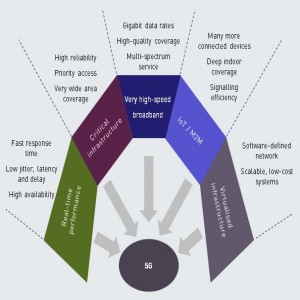Actualizado el 01/07/2025
5G - the path from vision, to realityEscrito por Janette Stewart el 02/05/2014 a las 19:19:133920
(Principal)  The mobile industry is becoming well accustomed to planning and implementing generational shifts in technology – the first generation of analogue cellular telephony networks gave way to 2G in the 1990s, 3G from 2000 onwards and, more recently, 4G. Each new generation of technology involves significant research and development effort and targeted standardisation before achieving commercial success. This article discusses the development of 5G technology and the challenges that it may bring to standards organisations.
The introduction of 3G networks over a decade ago was accompanied by the formation of the Third Generation Partnership Project (3GPP) – a worldwide standards development organisation that was created by uniting established regional standards bodies. 3GPP has overseen the evolution of the original 3G air interface and network specifications, followed by definition of the 4G air interface and network specifications, and subsequent 4G evolutions. Each generation of technology has been designed to meet internationally agreed visions and concepts for mobile communications as defined by the International Telecommunication Union (ITU).
Accordingly, no sooner have mobile operators started deploying 4G networks, than research and development into 5G has begun. Currently, 5G is a vision and wish-list, rather than a reality – with many parties, some with diverging views, seeking to drive the 5G agenda. Various regional research projects have now commenced, such as the EU’s Mobile and wireless communications Enablers for the Twenty-twenty Information Society (METIS) project, the aim of which is to “lay the foundations for 5G, the next generation mobile / wireless system”. The widespread interest in 5G is very positive in terms of the level of participation within the various research programmes. However, the diverging viewpoints emerging from different parties may pose a risk to the harmonised development of 5G. This is where the ITU potentially has a major role to play.
Work is already underway within the ITU-R to define the vision for 5G, which, in line with the approaches taken for 3G and 4G standardisation, will inform the technological options and standards for 5G infrastructure. However, established bodies may have to co-operate with each other, and with new organisations, in order to achieve the full 5G vision that is emerging at present. This is because what is emerging is that 5G is as much a wireless connectivity solution as it is a mobile technology – for example, it is envisaged that it will connect many more devices than are connected today, and many of those devices may not be mobile as such but part of the wider ‘Internet of Things’ (for example, meters, sensors, machines, etc.). The range of applications, and operating environments, is illustrated below (see Figure 1: Range of applications and environments in the 5G vision [Source: Analysys Mason, 2014])
Significant questions will have to be addressed in future – for example, whether 5G requires a new air interface to achieve the vision and incorporate all usage types, or whether it is an enhancement to the present 4G air interface, possibly with new network topology and/or new antenna configurations (for example, very large-scale MIMO). Questions are also being asked about spectrum requirements – it is most likely that bands above 6GHz will be required because they are suited to very dense infrastructure, plus lower bands to meet the coverage and reliability needs of some of the envisaged application areas.
A greater degree of spectrum sharing may be needed to accommodate these requirements. Various governments have already indicated their vision for wireless connectivity beyond 2020 involving more use of dynamic, secondary spectrum type operation.(1)
It is likely to take some time for the industry to address all the questions that the 5G vision is creating. Work is likely to continue on defining the 5G vision for another 1–2 years, with pre- and full standardisation following after this. Operational deployment of 5G is not likely before 2020, therefore, and it may be 2025 before systems are fully operational.
Although generational shifts in mobile technologies have tended to be evolutionary in nature, 5G might turn out to be significantly more revolutionary than 4G has been, not least in terms of industry structure and the mobile value chain. A shift towards wireless cloud and small-cell solutions suggests that new business models will emerge, for example. 5G might also result in the convergence of traditionally distinct sectors of the wireless industry.
Janette Stewart is a Principal at Analysys Mason, who specialises in wireless technologies and radio spectrum issues. She has around 20 years’ experience in radio engineering, spectrum policy and spectrum management. She is based in Analysys Mason’s office in Edinburgh. Janette began her career working for the UK spectrum regulator where she held various roles, latterly Senior Spectrum Engineer in the 3G Auction Team, where she was responsible for determining UK spectrum plans for the 3G licence award, interacting with CEPT and ITU working groups. Since joining Analysys Mason in 2001, her consulting experience includes researching market opportunities within the wireless sector, wireless network business planning, user requirement definition, spectrum strategy development and spectrum valuation. She has worked with a wide range of public and private sector clients including national regulators, fixed and mobile network operators, wireless industry trade associations and spectrum users. Recent projects have included advising on digital TV switchover strategy, award of digital dividend spectrum, technology co-existence in 800 MHz spectrum and 2.6 GHz spectrum valuation. She co-authors Analysys Mason’s Spectrum Quarterly, a quarterly newsletter on spectrum-related market developments.
(1) For example, the UK government highlights the future role of spectrum sharing in its recently published spectrum strategy, available at http://www.gov.uk/government/publications/spectrum-strategy.
|